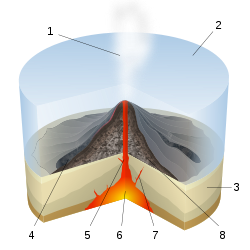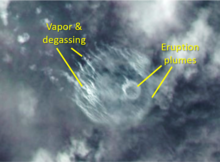
- Water vapor cloud
- Water
- Stratum
- Lava flow
- Magma conduit
- Magma chamber
- Dike
- Pillow lava


Submarine volcanoes are underwater vents or fissures in the Earth's surface from which magma can erupt. Many submarine volcanoes are located near areas of tectonic plate formation, known as mid-ocean ridges. The volcanoes at mid-ocean ridges alone are estimated to account for 75% of the magma output on Earth. Although most submarine volcanoes are located in the depths of seas and oceans, some also exist in shallow water, and these can discharge material into the atmosphere during an eruption. The total number of submarine volcanoes is estimated to be over one million (most are now extinct) of which some 75,000 rise more than 1 kilometre (0.62 miles) above the seabed. Only 119 submarine volcanoes in Earth's oceans and seas are known to have erupted during the last 11,700 years.
Hydrothermal vents, sites of abundant biological activity, are commonly found near submarine volcanoes.
Effect of water on volcanoes
The presence of water can greatly alter the characteristics of a volcanic eruption and the explosions of underwater volcanoes in comparison to those on land.
For instance, water causes magma to cool and solidify much more quickly than in a terrestrial eruption, often turning it into volcanic glass. The shapes and textures of lava formed by submarine volcanoes are different from lava erupted on land. Upon contact with water, a solid crust forms around the lava. Advancing lava flows into this crust, forming what is known as pillow lava.
Below ocean depths of about 2,200 metres (7,200 ft) where the pressure exceeds the critical pressure of water (22.06 MPa or about 218 atmospheres for pure water), it can no longer boil; it becomes a supercritical fluid. Without boiling sounds, deep-sea volcanoes can be difficult to detect at great distances using hydrophones.
The critical temperature and pressure increase in solutions of salts, which are normally present in the seawater. The composition of aqueous solution in the vicinity of hot basalt, and circulating within the conduits of hot rocks, is expected to differ from that of bulk water (i.e., of sea water away from the hot surfaces). One estimation is that the critical point is 407 °C (765 °F) and 29.9 MPa, while the solution composition corresponds to that of approximately 3.2% of NaCl.
Research
Scientists still have much to learn about the location and activity of underwater volcanoes. In the first two decades of this century, NOAA's Office of Ocean Exploration has funded exploration of submarine volcanoes, with the Ring of Fire missions to the Mariana Arc in the Pacific Ocean being particularly noteworthy. Using Remote Operated Vehicles (ROV), scientists studied underwater eruptions, ponds of molten sulfur, black smoker chimneys and even marine life adapted to this deep, hot environment.
Research from the ROV KAIKO off the coast of Hawaii has suggested that pahoehoe lava flows occur underwater, and the degree of the submarine terrain slope and rate of lava supply determine the shape of the resulting lobes.
In August 2019, news media reported a large pumice raft floating in the South Pacific between Fiji and Tonga. Subsequent scientific investigations revealed the pumice raft originated from the eruption of a nearby submarine volcano, which was directly observed as a volcanic plume in satellite images. This discovery will help scientists better predict for the precursors of a submarine eruption, such as low-frequency earthquakes or hydrophone data, using machine learning.
Seamounts
Many submarine volcanoes are seamounts, typically extinct volcanoes that rise abruptly from a seafloor of 1,000 metres (3,300 ft) - 4,000 metres (13,000 ft) depth. They are defined by oceanographers as independent features that rise to at least 1,000 metres (3,300 ft) above the seafloor. The peaks are often found hundreds to thousands of meters below the surface, and are therefore considered to be within the deep sea. An estimated 30,000 seamounts occur across the globe, with only a few having been studied. However, some seamounts are also unusual. For example, while the summits of seamounts are normally hundreds of meters below sea level, the Bowie Seamount in Canada's Pacific waters rises from a depth of about 3,000 metres (9,800 ft) to within 24 metres (79 ft) of the sea surface.
Identifying types of eruptions by sounds

There are two types of sound generated by submarine eruptions: One created by the slow release and bursting of large lava bubbles, while quick explosions of gas bubbles create the other one. Using this method to be able to distinguish the two can help measure the related affects on marine animals and ecosystems, the volume and composition of the lava flow can also be estimated and built into a model to extrapolate potential effects.
Scientists have connected sounds to sights in both types of eruptions. In 2009, a video camera and a hydrophone were floating 1,200 metres (3,900 ft) below sea level in the Pacific Ocean near Samoa, watching and listening as the West Mata Volcano erupted in several ways. Putting video and audio together let researchers learn the sounds made by slow lava bursting and the different noises made by hundreds of gas bubbles.
See also
References
- ^ Martin R. Speight, Peter A. Henderson, "Marine Ecology: Concepts and Applications", John Wiley & Sons, 2013. ISBN 978-1-4051-2699-1.
- Venzke, E., ed. (2013). "Holocene Volcano List". Global Volcanism Program Volcanoes of the World (version 4.9.1). Smithsonian Institution. Retrieved 18 November 2020.
- Venzke, E., ed. (2013). "How many active volcanoes are there?". Global Volcanism Program Volcanoes of the World (version 4.9.1). Smithsonian Institution. Retrieved 18 November 2020.
- Michael E. Q. Pilson, "An Introduction to the Chemistry of the Sea", 2nd edition. Cambridge University Press, 2013.
- Umino, Susumu; Lipman, Peter W.; Obata, Sumie (2000-06-01). "Subaqueous lava flow lobes, observed on ROV KAIKO dives off Hawaii". Geology. 28 (6): 503–506. Bibcode:2000Geo....28..503U. doi:10.1130/0091-7613(2000)28<503:SLFLOO>2.0.CO;2. ISSN 0091-7613.
- Guardian Staff (2019-08-25). "Massive pumice 'raft' spotted in the Pacific could help replenish Great Barrier Reef". the Guardian. Retrieved 2021-03-19.
- ^ "Satellite Sleuthing Detects Underwater Eruptions". Eos. 31 March 2020. Retrieved 2021-03-19.
- Nybakken, James W. and Bertness, Mark D., 2005. Marine Biology: An Ecological Approach. Sixth Edition. Benjamin Cummings, San Francisco
- "Scientists Discover and Image Explosive Deep-Ocean Volcano". NOAA. 2009-12-17. Retrieved 2009-12-19.
- Scientificamerican.com 2015-04-22 Undersea Volcano Explodes as Scientists Watch
- Dziak, R. P.; Bohnenstiehl, D. R.; Baker, E. T; Matsumoto, H.; Caplan-Auerbach, J.; Embley, R. W.; Merle, S. G.; Walker, S. L.; Lau, T.-K.; Chadwick, W. W. (2015). "Long-term explosive degassing and debris flow activity at West Mata submarine volcano" (PDF). Geophysical Research Letters. 42 (5): 1480–1487. Bibcode:2015GeoRL..42.1480D. doi:10.1002/2014GL062603.
External links
- Volcano Information from the Deep Ocean Exploration Institute, Woods Hole Oceanographic Institution
- Volcano World - now maintained by the Department of Geosciences at Oregon State University
- Britannica - Submarine Volcanoes
- United States Geological Survey
- Ring of Fire Exploration Mission
| Earth's landforms | |
|---|---|
| List of landforms | |
| Mountainous | |
| Continental plain | |
| Fluvial | |
| Glacial | |
| Oceanic and coastal landforms | |
| Volcanic | |
| Aeolian | |
| Artificial | |
| |


